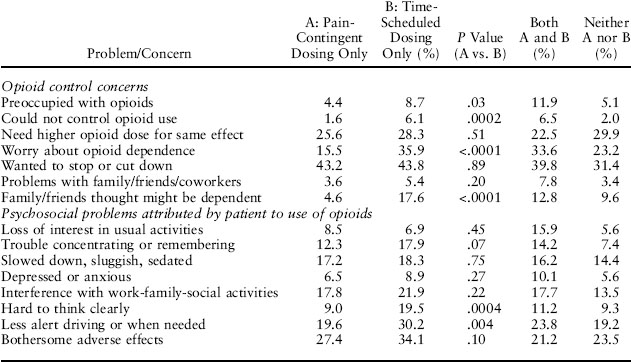Pain Management
Chronic Pain Management
Time-scheduled vs. pain-contingent opioid dosing in chronic opioid therapy
Von Korff M, Merrill JO, Rutter CM, et al (Group Health Res Inst, Seattle, WA; Univ of Washington School of Medicine, Seattle; et al) Pain 152:1256-1262, 2011§
Evidence Ranking
• B
Expert Rating
• 2
Abstract
Some expert guidelines recommend time-scheduled opioid dosing over pain-contingent dosing for patients receiving chronic opioid therapy (COT). The premise is that time-scheduled dosing results in more stable opioid blood levels and better pain relief, fewer adverse effects, less reinforcement of pain behaviors, and lower addiction risk. We report results of a survey of 1781 patients receiving COT for chronic noncancer pain, in which 967 reported time-scheduled opioid dosing only and 325 reported pain-contingent opioid dosing only. Opioid-related problems and concerns were assessed with the Prescribed Opioids Difficulties Scale. We hypothesized that respondents using time-scheduled opioid dosing would report significantly fewer problems and concerns than those using pain-contingent dosing. Patients receiving time-scheduled dosing received substantially higher average daily opioid doses than those using pain-contingent dosing (97.2 vs. 37.2 mg average daily dose morphine equivalents, P < .0001). Contrary to expectation, time-scheduled opioid dosing was associated with higher levels of patient opioid control concerns than pain-contingent dosing (6.2 vs. 4.8, P = .008), after adjusting for patient and drug regimen differences. Opioid-related psychosocial problems were somewhat greater among patients using time-scheduled dosing, but this difference was nonsignificant after controlling for patient and drug regimen differences (5.9 vs. 5.0, P = .14). Time-scheduled dosing typically involved higher dosage levels and was associated with higher levels of patient concerns about opioid use. Controlled comparative effectiveness research is needed to assess benefits and risks of time-scheduled opioid dosing relative to pain-contingent opioid dosing among COT patients in ambulatory care (Table 4).
Stay updated, free articles. Join our Telegram channel

Full access? Get Clinical Tree




